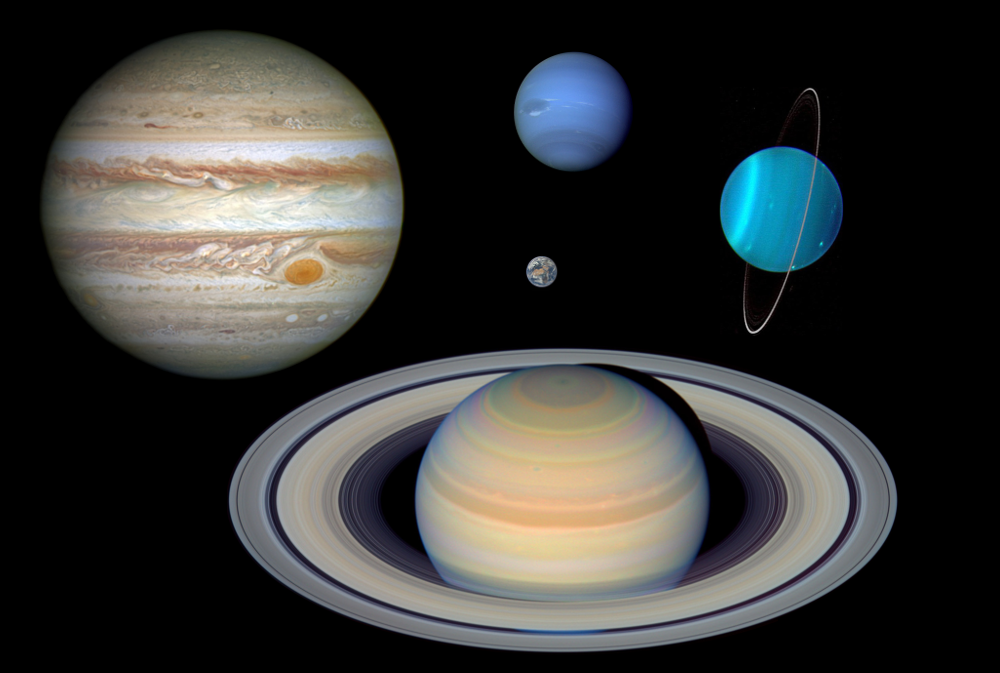
Source for the images can be found at http://spiff.rit.edu/classes/resceu/ss_planets/earth_moon_lineup.html
 Copyright © Michael Richmond.
This work is licensed under a Creative Commons License.
Copyright © Michael Richmond.
This work is licensed under a Creative Commons License.
We'll start by introducing the planets of our outer Solar System, which are quite different from the terrestrial planets we've studied so far.
But the main topic for today is the planet Jupiter.
Why do we call them "gas giants?" Because they are really big planets, much larger than the Earth. Look!

Source for the images can be found at
http://spiff.rit.edu/classes/resceu/ss_planets/earth_moon_lineup.html
Here's another comparison:
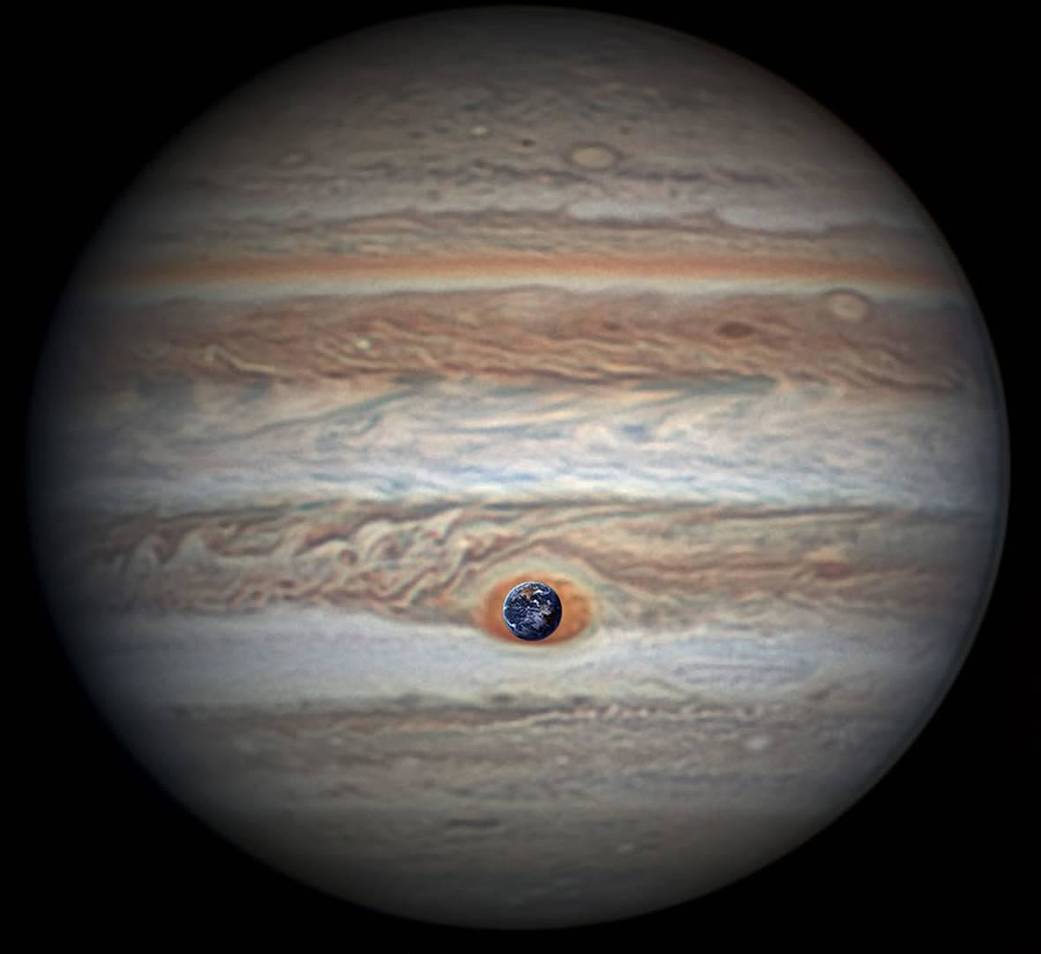
Image courtesy of
NASA/JPL-Caltech/SwRI/MSSS/Christopher Go
We can make the comparison quantitative, too. If we do, we can learn another difference between the terrestrial and gas giant planets.
Planet Radius Mass Density
(m) (kg) (kg/m^3)
-----------------------------------------------------------------------
Earth 6.37 x 106 5.97 x 1024
Jupiter 71.49 x 106 1898 x 1024
Saturn 60.27 x 106 568 x 1024
Uranus 25.56 x 106 86.8 x 1024
Neptune 24.76 x 106 102 x 1024
-----------------------------------------------------------------------
The densities of the giant planets are much lower than the densities of the terrestrial planets. Note that Saturn's density is less than that of water. It is often stated that
| Saturn would float in water! |

Image courtesy of NASA |
Rhett Allen provides some pretty good arguments against this scenario , but if it helps you to remember this feature of the giant planets, then, go right ahead and think it.
So, why are the densities of the gas giants so low? Well, you could just read the next section heading ...
Planets in the inner solar system are composed primarily of solid matter. The Earth, for example, has an iron core, a semi-solid mantle of dense minerals, with a solid crust floating on top. The atmosphere is just a tiny extra layer -- the skin of an apple has roughly the same relative thickness as the atmosphere of the Earth.
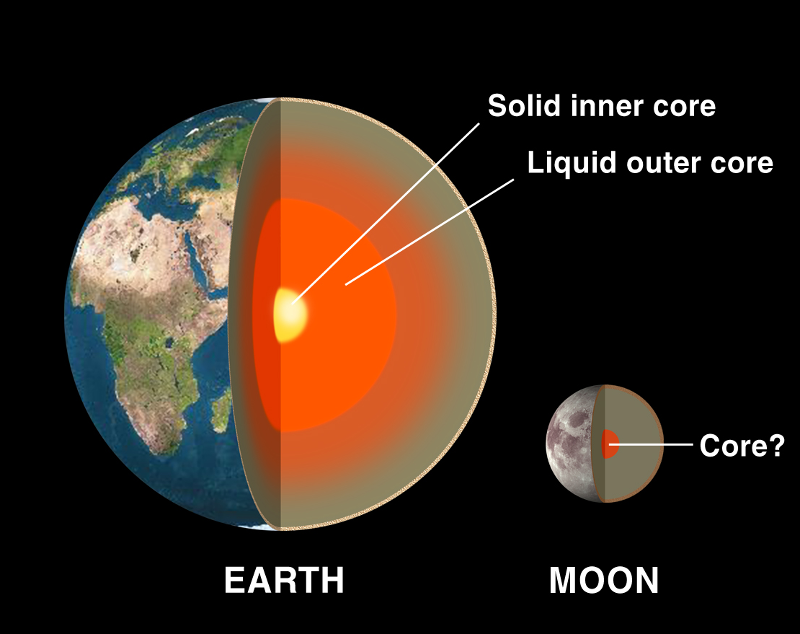
Image courtesy of
NASA (and Wikimedia)
But the atmospheres of the giant planets are more than a thin skin -- they occupy a large portion of the entire volume. In Jupiter and Saturn, the gaseous atmosphere accounts for roughly half the planet's radius; in Uranus and Neptune, perhaps a quarter.

Image courtesy of
NASA/Lunar and Planetary Institute
You already know that Jupiter is big. We covered that earlier.

Source for the images can be found at
http://spiff.rit.edu/classes/resceu/ss_planets/earth_moon_lineup.html
But that picture doesn't give an accurate representation for how MASSIVE Jupiter is, compared not only to the Earth, but to everthing else. Do the math:
mass of large bodies, in kg
Everything but Jupiter Jupiter by itself
----------------------------------------------------------------------------
Mercury 0.33 x 1024 Jupiter 1898 x 1024
Venus 4.87 x 1024
Earth 5.97 x 1024
Mars 0.64 x 1024
Saturn 568 x 1024
Uranus 86.8 x 1024
Neptune 102 x 1024
Pluto 0.01 x 1024
---------------------------- ------------------------------
total total
Some scientists have described the Solar System as "the Sun, Jupiter, and bits of rubble," or words to that effect. To some extent, it's true: Jupiter is so much more massive than the other planets that it dominates much of the dynamics.
For example, the orbits of asteroids show big gaps at locations which would yield regular perturbations by Jupiter ... but not at locations which are related to the orbital periods of Saturn or Uranus or Mars.
Another example: as we will see later in the course, one of the ways that astronomers search for planets around other stars is to look for changes in the radial velocities of the host stars due the gravitational pull of their planets.
How aliens could use the radial velocity technique to detect Jupiter
![]()
(Click the image below to start a demonstration of the effect)
Jupiter's large mass mean that its gravitational force pulls the Sun around its common center of mass strongly. In fact, the Sun makes a small orbit around this center of mass with a speed of about 12 meters per second, around 27 miles per hour. That doesn't sound like much ...
Q: How fast does the Earth move in its orbit
around the Sun?
(Hint: it travels a circle of radius 1 AU (= 150 million km) in 1 year)
(Hint: there are about π x 107 seconds in a year)
Indeed, the Sun's motion due to Jupiter's pull is pretty slow; but astronomers have created instruments which can measure such small speeds. If there were a Jupiter-like planet orbiting around a Sun-like star, then we could detect it pretty easily!
That's not true of most other planets. The Earth, for example, does exert a gravitational force of its own on the Sun; but the motion of the Sun due to the Earth's influence is less than 1 meter per second, which is smaller than our current instruments could detect reliably.
There are several other ways to detect planets around other stars. One of the most common which we will discuss in detail later, is the transit method, in which one stares at a star for a long time, measuring its brightness over and over and over, looking for a brief little dip which might indicate that a planet has passed in front of it.
Now, this method works best when the planet is large -- it will block a lot of light, and the dip in brightness will be easy to detect. So, which will create a more obvious transit: Jupiter, or the Earth?
Right -- Jupiter will block more light. In fact, Jupiter will block about 1 percent of the Sun's light, creating a dip which is pretty easy to detect with ordinary telescopes. But the Earth blocks only about 0.008 percent of the Sun's light; only special telescopes in orbit can possibly detect such a tiny change in brightness.
Planets with the same sort of giant size and tremendous mass as Jupiter are the easiest for astronomers to detect around other stars. As you will see in a few weeks, our catalogs of extrasolar planets are full of alien "Jupiters".
The Earth rotates on its axis once every 23 hours, 56 minutes and 4 seconds (= 23.9345 hours), as you all know.
What? You though it was once every 24 hours? That's only if you wait until the Sun returns to its previous location in the sky. We astronomers are accustomed to watching stars, and waiting for a star to make one complete circuit of the sky. The difference -- about 4 minutes -- is due to the Earth's orbital motion around the Sun, which shifts the Sun backwards a bit in the sky.
But Jupiter rotates much more quickly. The sidereal (which means "relative to the stars") rotation rate of Jupiter is only about 9 hours, 55 minutes and 30 seconds (9.925 hours). Astrophotographer Damian Peach was able to record one full rotation of the planet during a single night in 2016. Click on the image below to see his video.
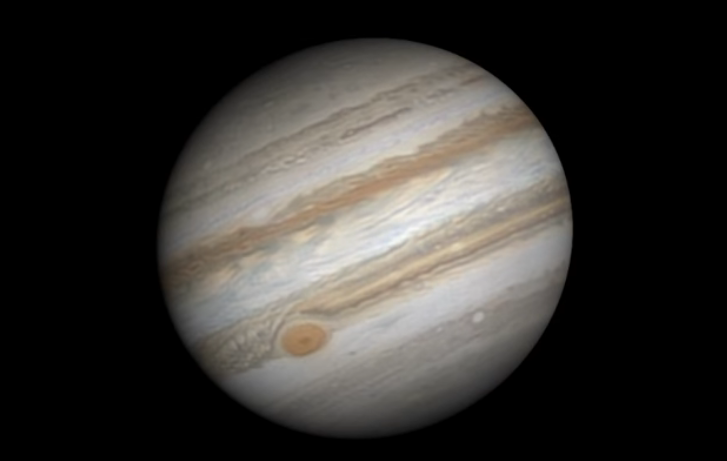
Image and movie of Jupiter
copyright
Damian Peach
planet radius rotation period equatorial speed
(km) (hours) (km/sec)
----------------------------------------------------------------------
Earth 6,378 23.9345
Jupiter 71,942 9.9250
----------------------------------------------------------------------
The centrifugal force due to this rapid rotation pulls the atmosphere near the equator outward to form a very prominent bulge. If you look carefully, you can see that Jupiter looks flattened, pole-to-pole.
The rapid rotation helps to drive the high wind speeds in Jupiter's atmosphere. Relative to the overall rotation of the planet, gas in the belts and zones move at speeds of several hundred km per hour.
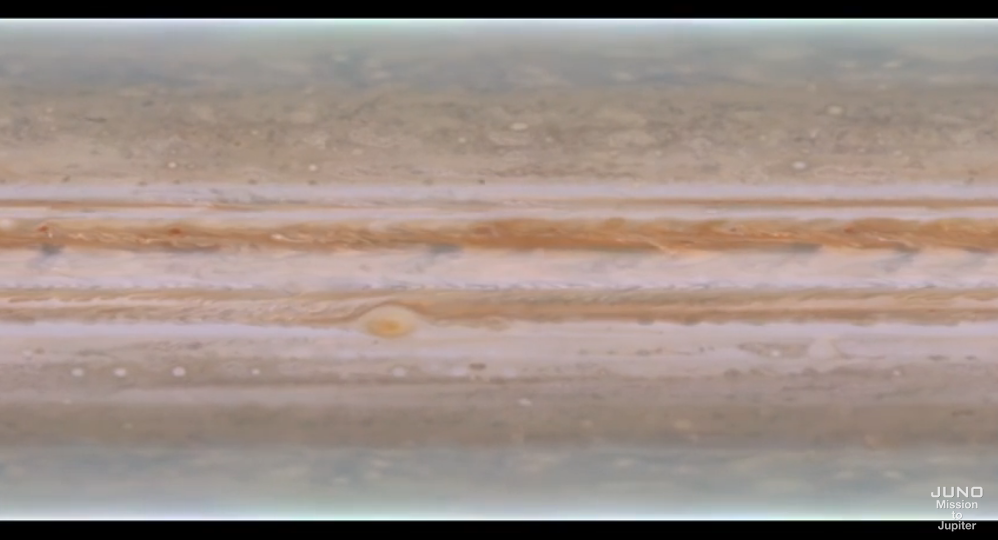
Movie of Jupiter taken by Cassini spacecraft,
courtesy of
NASA and Project Juno
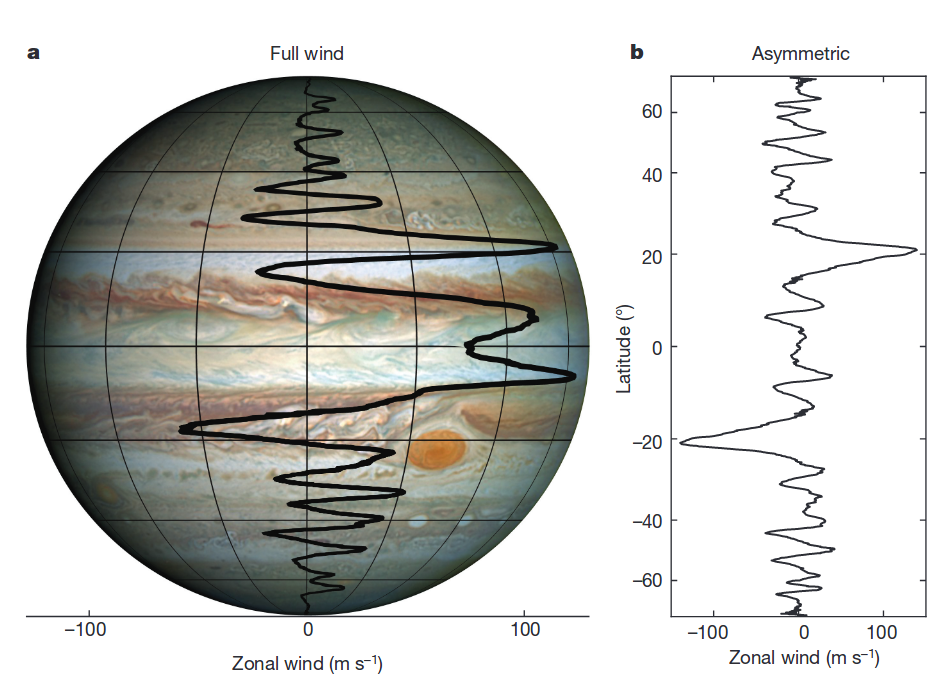
Figure 1 taken from
Kaspi et al., Nature 555, 223 (08 March 2018)
It may not be a star, but Jupiter is still an impressive -- and dangerous -- object. Swirling around it, and extending away for millions of kilometers, is a very strong magnetic field.

Image and movie courtesy of
NASA's Scientific Visualization Studio and JPL NAIF
Like the Earth's magnetic field, it has a north pole near one end of its rotational axis, and a south pole near the other. Notice how the magnetic field lines intersect with the atmosphere in a ring-like region around each of the poles.
But Jupiter's magnetic field is much stronger than Earth's. Earth's field has a strength of about 0.5 Gauss at its surface, but Jupiter's is about 4 Gauss near the cloudtops.
Why are magnetic fields dangerous? The problem isn't with the fields themselves -- they aren't strong enough to damage the atoms and molecules in our bodies. The problem is with the "guests" that like to visit the magnetic field: charged particles. Charged particles will spiral around and around a magnetic field, following it wherever it goes.

Image courtesy of
UCLA EPSS/NASA SVS
If those charged particles happen to follow magnetic field lines into the atmosphere of the Earth, they smash into atmospheric atoms, exciting them so that the atoms glow with an eerie light. We call these beautiful displays of glowing air aurorae (singular: aurora).
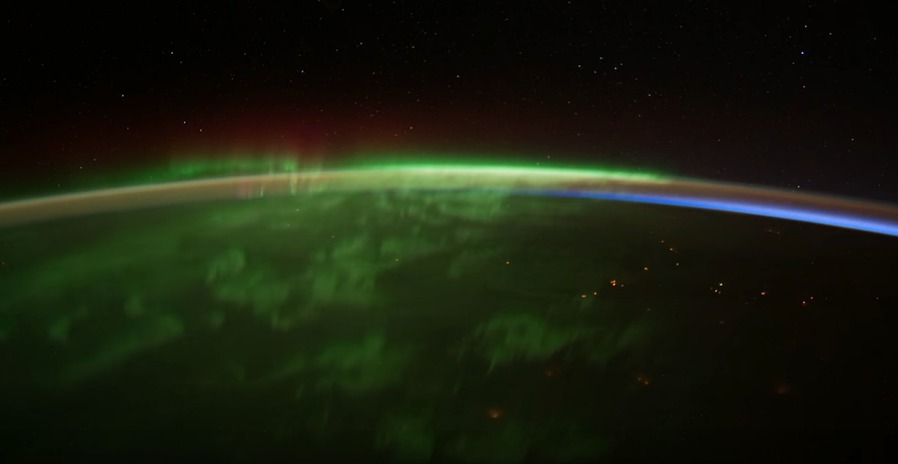
Image and video of aurora from ISS courtesy of
Image Science & Analysis Laboratory, NASA Johnson Space Center
You can also see a similar video
on Youtube.
Since Jupiter has a strong magnetic field, we might expect to see aurorae near its poles. And, in fact, we do; in this still image from HST ...

HST image courtesy of
NASA, ESA, and J. Nichols (University of Leicester)
... and from the Juno spacecraft currently in orbit around Jupiter.
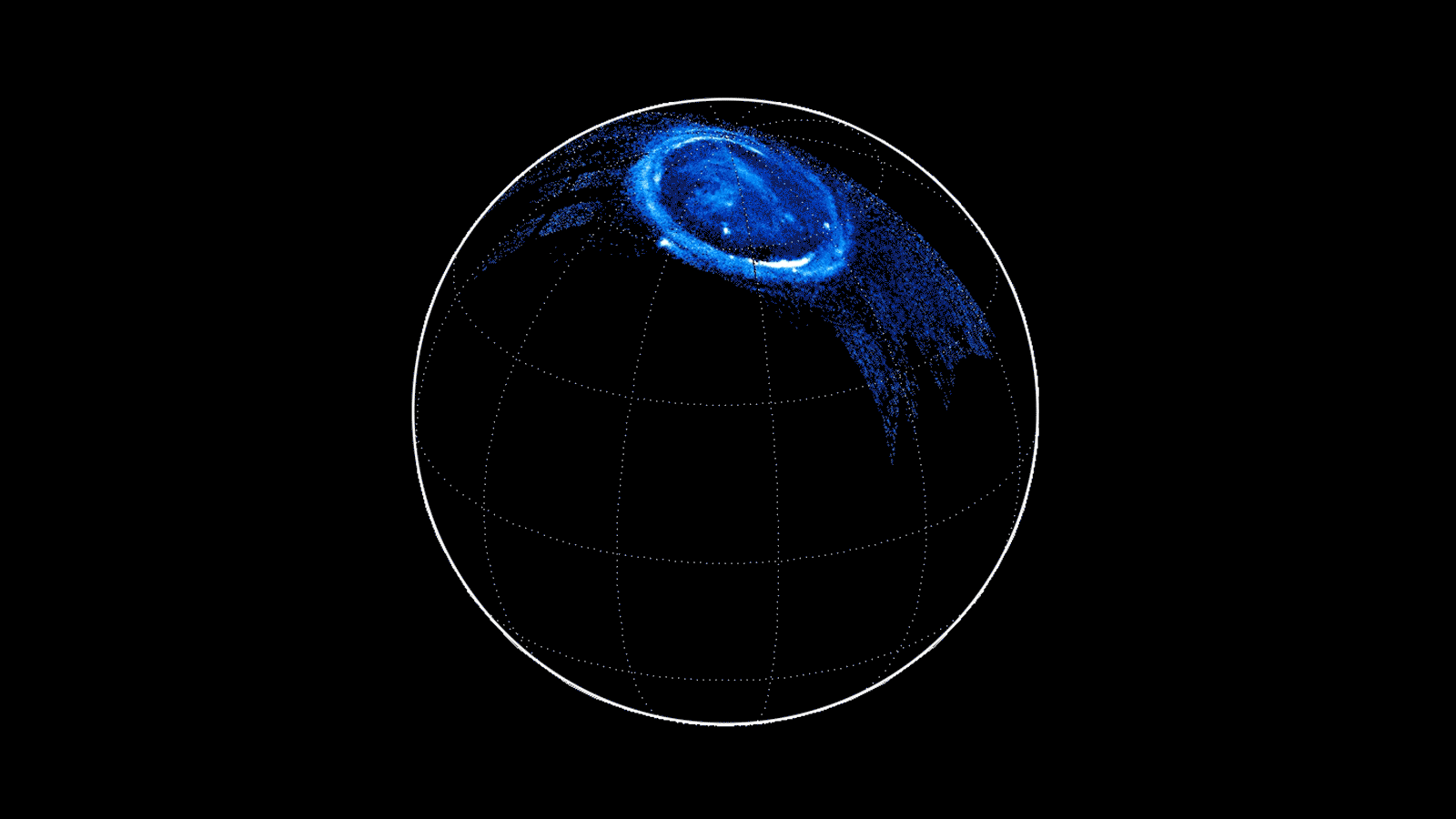
So where's the danger? The danger lies in the charged particles which can become trapped within a strong magnetic field. Although some of the particles may follow the field lines into the atmosphere and transfer their energy to atoms of gas, many particles just cycle back and forth, from northern pole to southern pole, remaining in space. The number of particles grows and grows, creating a region of space full of energetic electrons and protons.
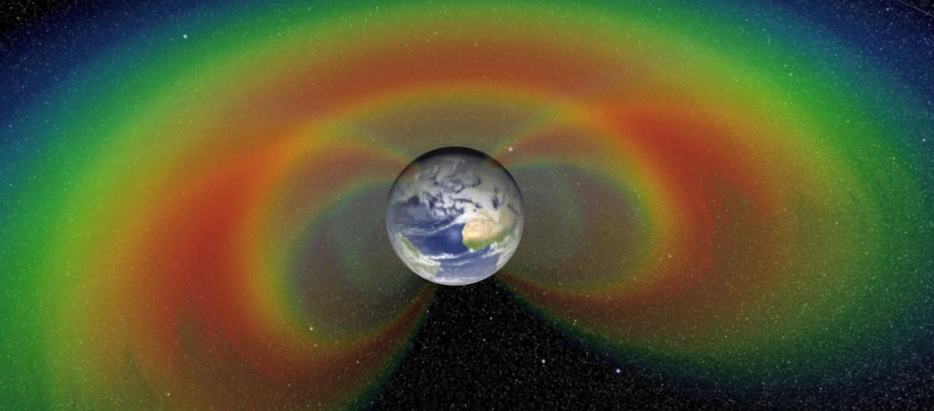
Image and movie courtesy of
NASA/Goddard Space Flight Center Scientific Visualization Studio
We call these regions around the Earth the van Allen radiation belts. The strongest concentrations of particles are found in two regions: an inner belt, and an outer belt.
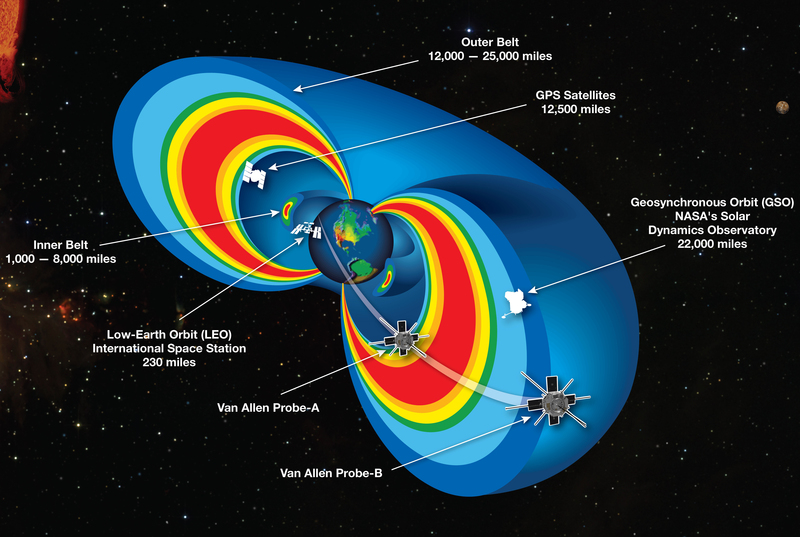
Image courtesy of
NASA
Fortunately for astronauts and satellites, the regions between these belts are nearly free of charged particles.
Jupiter's magnetic field also collects charged particles, which means that the space around Jupiter can be hazardous to spacecraft and humans. The strongest concentrations are very close to the planet's cloudtops ...
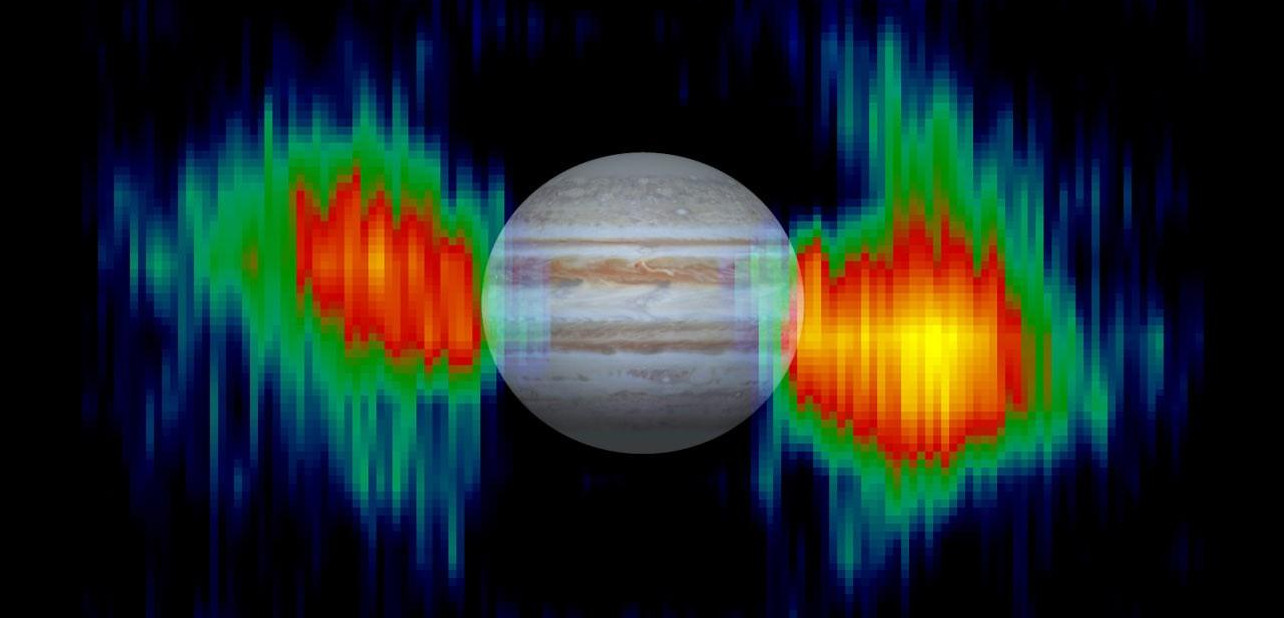
Image modified slightly from the made by
NASA/JPL/Space Science Institute
... but there are still high levels of energetic electrons at the distances of the big Galilean moons:

Figure 27.4, taken from
Bolton et al., Chapter 27 in "Jupiter: The planet, satellites, and
magnetosphere", Cambridge University Press, 2004.
How bad would be it for an unshielded human to visit the region around Jupiter? Perhaps you've heard of the moon called Europa; it appears to have a subsurface ocean covered by an icy crust. Some science fiction writers have imagined strange creatures living beneath the ice ...
Well, the graph below shows the radiation levels at various distances below the surface of Europa. The y-axis indicates how many "rads" of radiation would strike a human EACH SECOND.
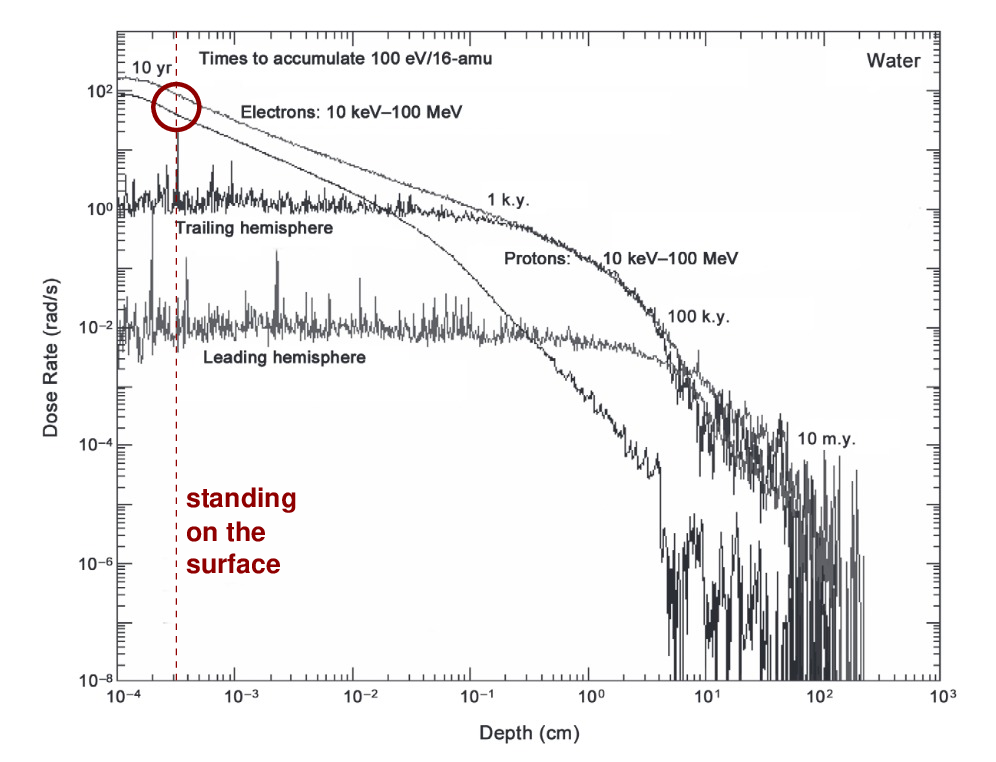
Figure 10 taken from
Paranicas et al., "Europa's Radiation Environment and Its Effects on the Surface", in "Europa", University of Arizona (2009)
Q: A dose of about 1000 rad will cause acute radiation poisoning
to a human being.
How long would an unshielded human last on Europa?
If you want to figure out how long you might live -- long enough to land the ship? Long enough to set up a shielded base? Long enough to return to Earth (ha!) -- try reading
 Copyright © Michael Richmond.
This work is licensed under a Creative Commons License.
Copyright © Michael Richmond.
This work is licensed under a Creative Commons License.